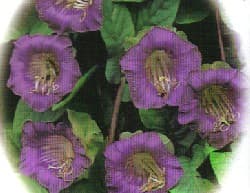How to Grow Cobaea Scandens Flower

About Growing Cobaea Scandens Plants in Your Home Flower Garden
Cobaea Scandens plants are a great flower to grow in your home flower garden. The bell-shaped flowers, looking like a cup or saucer, are an attractive conversation piece, growing from a trellis, fence, or other support. Sometimes called the “Cup and Saucer Vine” or “Cathedral Bells”, it is a very decorative plant, with lush, green foliage. Perhaps best of all, growing Cobaea Scandens annuals in your backyard will attract hummingbirds.
Native to Mexico and Peru, it was discovered in the 17th century, by Father Cobo, a Jesuit missionary. Some varieties of Cobaea Scandens can grow up to 33 feet tall if over-wintered in warm areas where the temperatures do not go below 40 degrees. These easy-to-grow plants are most often grown as annuals and usually grow 4-6 feet or more in a season. These climbers need something to climb on. So, provide them with a trellis, fence, or post, and watch them grow! Or, try growing them down off of a balcony or deck.
Cobaea Scandens flowers attract hummingbirds.
Cobaea Scandens Plant Specifics
Flower Colors: Colors include shades of orange, pink, rose, violet, and white.
Flowers Bloom: Summer through Fall.
Plant Height: The vine can grow over thirty feet, depending upon variety.
Light Requirements: Full sun.
Ideal Soil pH: 6.1 – 6.5.
Hardiness Zone: 9 – 11. This versatile plant grows well in most hardiness zones.
Toxicity: It is not known to be toxic.
Native To: Mexico and other parts of Central America.
Plant Type: It’s actually a perennial vine that is most often grown as an annual.
Botanical Name: Cobaea Scandens
Other Names: Cathedral Bells, Cup and Saucer Vine, air plant, life plant, miracle leaf, Goethe plant, and love bush.
Are Cobaea Scandens Plants Edible?
NO!!
The plant is not known to be poisonous. However, we found no reference to the plant being used for human or animal consumption.
Medicinal Uses for Cobaea Scandens Plants
While no one eats any part of this plant, it has many medicinal applications. Cobaea Scandens has antibacterial, antiviral, antimicrobial, antifungal, antihistamine, and anaphylactic properties.
Some of the medicinal uses are:
- It lowers high blood pressure.
- Reduces swelling.
- Looking to increase your energy level? Make tea from the stems and leaves.
- The tea eases menstrual cramps.
- The tea also clears your sinuses.
Light Requirements
For the best performance, give this plant full sunlight all day long. It needs energy for the sun to fuel its fast and steady growth.
And, insufficient light can cause the flowers to fail to bloom.
Annual Cobaea Scandens Plant Propagation
Cobaea Scandens plants are grown from seeds. While the plant is easy to grow, getting the seeds to germinate can be a bit of a challenge. Cobaea Scandens seeds take 3-4 weeks to germinate. We strongly recommend an indoor start. In areas with a long growing season, the Cup and Saucer Vine can be directly seeded into your flower garden. If you start them outdoors, make sure to mark where they are planted, and keep well weeded, so you can spot them when they emerge.
They can also be propagated from cuttings.
Transplant seedling plants into your garden, after the last frost date for your area. Space plants 8-10″ apart. Provide something for them to grow on for maximum growth potential. The plants tolerate a little crowding. If growing in hanging planters, space them a little closer.
Days to Germination: Cobaea Scandens seeds germinate in 10 to 14 days.
How to Grow Annual Cobea Scadens Flowers
Grow Cobaea Scandens plants in full sun.
The plants tolerate a variety of soils, but rich soils, with ample amounts of organic matter, help to promote maximum growth.
The soil should be well-draining. For optimal growth, use a general-purpose fertilizer every 2-3 weeks. A month before the blooming period, switch to a fertilizer high in phosphorous to promote blooms.
Keep the soil moist. Watering during dry periods is important to sustain fast growth and big, bright blooms.
Plants bloom from late summer to fall.
Cobaea Scandens plants are annuals. They succumb to frost and freezes.
Pruning Cobaea Scandens Plants
Remove any dead, unsightly, or diseased leaves. Otherwise, keep your pruning shear on the shelf of your garden shed for this plant.
You do not need to deadhead the spent flower blooms. That’s good news as many of the flowers will be high on the vine and out of reach.
Insects and Plant Disease
Cobaea Scandens plants seldom have problems with insects and disease. Red spider mites are an occasional pest. If insect or disease problems occur, treat early with organic or chemical insect repellents and fungicides.
Also see: Plant Problems – causes and cures.
Related Articles
People who read this article will also like:
Recipes– May we suggest Cathedral Cookies
Please support our site. Shop for:
- rmmatthews100@hotmail.com
- 585-721-6528
- Rochester, NY
©1999-2024 GardenersNet.Com, All Rights Reserved

